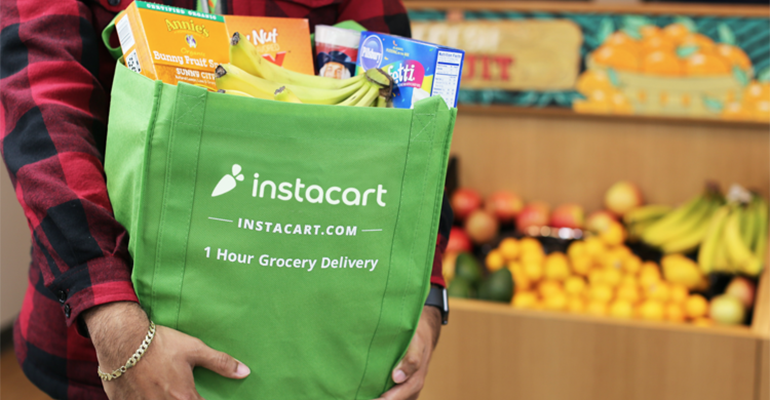In a widely expected move, online grocery delivery provider Instacart said it will now “wind down” its partnership with Amazon-owned Whole Foods Markets.
Apoorva Mehta, founder and CEO of Instacart, said in a blog post Thursday that the San Francisco-based company will start pulling its personal shoppers — who pick, bag and deliver online grocery orders — from Whole Foods stores. Instacart has provided delivery from Whole Foods since 2014.
“Our relationship is now beginning to wind down,” Mehta said in “The Instacart Checkout” blog. “The first phase of this transition starts today, which means that we have to start scaling back our in-store shopper operations within Whole Foods locations.”
Currently, Instacart has 1,415 personal shoppers at 76 Whole Foods stores. The company said it expects to lay off 243 beginning on Feb. 10, 2019.
“In the months that follow, we expect to ramp down all remaining Whole Foods in-store shopping operations in preparation for Whole Foods to fully exit our marketplace in the coming months,” Mehta said.
After Amazon closed its acquisition of Austin, Texas-based Whole Foods in late August 2017, many retail grocery industry observers believed it was just a matter of time before the supermarket chain’s relationship with Instacart would end.
Amazon soon began integrating Whole Foods stores with its hugely successful Prime customer benefits program. As of June 27, all of the roughly 470 Whole Foods U.S. stores were connected with Prime.
While the Prime integration proceeded, Amazon also ramped up its Prime Now online grocery delivery program. Prime Now launched at Whole Foods in February and steadily expanded to major metropolitan markets nationwide. As of early November, the service was available at Whole Foods stores in 63 cities. More recently, the e-tail giant expanded its click-and-collect grocery service. Prime Now Pickup, launched at Whole Foods in early August, is now offered through the chain’s stores in 22 markets.
Instacart, founded in 2012, also has seen rapid expansion — including a growth spurt since the Amazon-Whole Foods deal. The company now works with more than 300 retailers, representing over 15,000 grocery stores in 4,000 cities, and has a base of 70,000 personal shoppers. Its online grocery marketplace and delivery service is accessible to more than 70% of U.S. households, including all 50 states, and to over 50% of Canadian households.
And early last month, Instacart began the national launch of Instacart Pickup. The click-and-collect service is set to roll out to nearly 200 grocery stores in 25 metro markets.
“Today, we have the largest retail marketplace in the online grocery space. We’re proud of the partnerships we’ve built with national, regional and local retailers,” Mehta said Thursday in the blog.
Instacart expects to place more than 75% of all its affected personal shoppers at Whole Foods in new in-store shoppers jobs at other retailers in their area, he said. Personal shoppers at Whole Foods that Instacart places in a new role will receive a transfer bonus. Those who elect to not shift to a new job or cannot do so will be offered a minimum of three-month separation package based on their 2018 maximum monthly pay plus tenure-based compensation.
Mehta added that most of Instacart’s personal shoppers work for multiple retailers besides Whole Foods. “For those shoppers who support several grocers, this transition will not impact you,” he said. “For Whole Foods specifically, our multi-store shoppers will still be able to pick, pack and deliver from Whole Foods locations nationwide until they exit our marketplace.”





